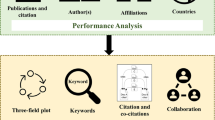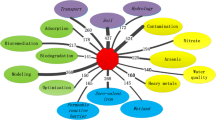Abstract
A scientometric analysis based on the Scopus database was conducted to provide insight into research activities on the occurrence of potentially toxic elements (PTEs) (As, Cd, Co, Cr, Cu, Hg, Ni, Pb, Sb, and Zn) in groundwater during 1970–2019. The selection of these PTEs was based on their significance concerning their reference frequency in environmental science and pollution research (ESPR) studies and their toxicity to living organisms. The analysis utilizes data about the quantity, type, journal, geographical, institutional, and funding patterns of publications. The results indicate that the publications’ annual output has increased over the years, and especially after 2000, it presents a remarkable growth rate. The most studied PTEs were As and Pb; nevertheless, the research on the rest of PTEs cannot be neglected as it shows continuously increasing trends over time. The evolution of instrumentation and the dissemination of contamination case studies that affect a large part of the world population contributed significantly to the scientific community and relative stakeholders’ interest. According to the analysis, the USA and China are the two principal countries with the most considerable contribution, producing the most research regarding the number of publications, research institutions, and funding sponsors. China owns the most influential research institution (i.e., Chinese Academy of Sciences) and largest funding sponsor (i.e., National Natural Science Foundation of China; ≈5% of global funding) on a worldwide scale due to its investment in research and development (R&D) and is expected to become the greatest force in the future.








Similar content being viewed by others
Data availability
Data will be made available on request.
References
Ahmad A, Bhattacharya P (2019) Arsenic in drinking water: is 10 μg/L a safe limit? Curr Pollut Rep 5:1–3. https://doi.org/10.1007/s40726-019-0102-7
Alarcón-Herrera MT, Martin-Alarcon DA, Gutiérrez M, Reynoso-Cuevas L, Martín-Domínguez A, Olmos-Márquez MA, Bundschuh J (2020) Co-occurrence, possible origin, and health-risk assessment of arsenic and fluoride in drinking water sources in Mexico: geographical data visualization. Sci Total Environ 698:134168. https://doi.org/10.1016/j.scitotenv.2019.134168
Chai S, Shih W (2016) Bridging science and technology through academic-industry partnerships. Res Policy 45(1):148–158. https://doi.org/10.1016/j.respol.2015.07.007
Chen, Q., Fan, G., Na, W., Liu, J., Cui, J., & Li, H. (2019). Past, present, and future of groundwater remediation research: a scientometric analysis. International Journal of Environmental Research and Public Health. MDPI AG
Fu HZ, Wang MH, Ho YS (2013) Mapping of drinking water research: a bibliometric analysis of research output during 1992-2011. Sci Total Environ 443:757–765. https://doi.org/10.1016/j.scitotenv.2012.11.061
Haunschild R, Bornmann L, Marx W (2016) Climate change research in view of bibliometrics. PLoS ONE 11(7):e0160393. https://doi.org/10.1371/journal.pone.0160393
Hem, J. D. (1985) Study and interpretation of the chemical characteristics of natural water. US Geological Survey Water-Supply Paper, 2254
Hu J, Ma Y, Zhang L, Gan F, Ho YS (2010) A historical review and bibliometric analysis of research on lead in drinking water field from 1991 to 2007. Sci Total Environ 408(7):1738–1744. https://doi.org/10.1016/j.scitotenv.2009.12.038
Huang L, Chen K, Zhou M (2020a) Climate change and carbon sink: a bibliometric analysis. Environ Sci Pollut Res 27(8):8740–8758. https://doi.org/10.1007/s11356-019-07489-6
Huang L, Zhou M, Lv J, Chen K (2020b) Trends in global research in forest carbon sequestration: a bibliometric analysis. J Clean Prod 252:119908. https://doi.org/10.1016/j.jclepro.2019.119908
Jarvis, P., & Fawell, J. (2021). Lead in drinking water – an ongoing public health concern? Current Opinion in Environmental Science and Health. Elsevier B.V. https://doi.org/10.1016/j.coesh.2021.100239
Khalidy R, Santos RM (2021) Assessment of geochemical modeling applications and research hot spots—a year in review. Environ Geochem Health. https://doi.org/10.1007/s10653-021-00862-w
Kruk MK, Mayer B, Nightingale M, Laceby JP (2020) Tracing nitrate sources with a combined isotope approach (δ15NNO3, δ18ONO3 and δ11B) in a large mixed-use watershed in southern Alberta, Canada. Sci Total Environ 703:135043. https://doi.org/10.1016/j.scitotenv.2019.135043
Kubier A, Wilkin RT, Pichler T (2019) Cadmium in soils and groundwater: a review. Appl Geochem 108:104388. https://doi.org/10.1016/j.apgeochem.2019.104388
Kumar M, Goswami R, Patel AK, Srivastava M, Das N (2020) Scenario, perspectives and mechanism of arsenic and fluoride co-occurrence in the groundwater: a review. Chemosphere 249:126126. https://doi.org/10.1016/j.chemosphere.2020.126126
Lavis JN, Robertson D, Woodside JM, McLeod CB, Abelson J (2003) How can research organizations more effectively transfer research knowledge to decision makers? Milbank Q 81(2):221–248. https://doi.org/10.1111/1468-0009.t01-1-00052
Li W, Zhao Y (2015) Bibliometric analysis of global environmental assessment research in a 20-year period. Environ Impact Assess Rev 50:158–166. https://doi.org/10.1016/j.eiar.2014.09.012
Li C, Wang J, Yan B, Miao A-J, Zhong H, Zhang W, Ma LQ (2020) Progresses and emerging trends of arsenic research in the past 120 years. Crit Rev Environ Sci Technol 51:1–48. https://doi.org/10.1080/10643389.2020.1752611
Lin H, Zhu Y, Ahmad N, Han Q (2019) A scientometric analysis and visualization of global research on brownfields. Environ Sci Pollut Res 26(17):17666–17684. https://doi.org/10.1007/s11356-019-05149-3
Masic I (2016) Scientometric analysis: a technical need for medical science researchers either as authors or as peer reviewers. J Res Pharm Pract 5(1):1–6. https://doi.org/10.4103/2279-042x.176562
Mokhnacheva YV, Tsvetkova VA (2020) Bibliometric analysis of soil science as a scientific area. Eurasian Soil Sc 53:838–844. https://doi.org/10.1134/S1064229320060095
Mukherjee A, Sengupta MK, Hossain MA, Ahamed S, Das B, Nayak B, Lodh D, Rahman M, Chakraborti D (2006) Arsenic contamination in groundwater: a global perspective with emphasis on the Asian scenario. J Health Popul Nutr. https://doi.org/10.3329/jhpn.v24i2.727
Nature (2021). China’s five-year plan focuses on scientific self-reliance. 10.1038/d41586-021-00638-3. Accessed 29 Mar 2021
Nishy P, Saroja R (2018) A scientometric examination of the water quality research in India. Environ Monit Assess 190(4):225. https://doi.org/10.1007/s10661-018-6601-y
Niu, B., Loáiciga, H. A., Wang, Z., Zhan, F. B., & Hong, S. (2014) Twenty years of global groundwater research: a Science Citation Index Expanded-based bibliometric survey (1993-2012). Journal of Hydrology. Elsevier B.V. https://doi.org/10.1016/j.jhydrol.2014.07.064
OECD (2021). Organization for Economic Co-operation and Development. https://www.oecd.org/sdd/china-and-the-oecd-statistics-directorate.htm. Accessed 29 Mar 2021
Ouyang, W., Wang, Y., Lin, C., He, M., Hao, F., Liu, H., & Zhu, W. (2018). Heavy metal loss from agricultural watershed to aquatic system: a scientometrics review. Science of the Total Environment. Elsevier B.V. https://doi.org/10.1016/j.scitotenv.2018.04.434
Papazotos P, Vasileiou E, Perraki M (2019) The synergistic role of agricultural activities in groundwater quality in ultramafic environments: the case of the Psachna basin, Central Euboea, Greece. Environ Monit Assess 191:317. https://doi.org/10.1007/s10661-019-7430-3
Papazotos P, Vasileiou E, Perraki M (2020) Elevated groundwater concentrations of arsenic and chromium in ultramafic environments controlled by seawater intrusion, the nitrogen cycle, and anthropogenic activities: the case of the Gerania Mountains, NE Peloponnese, Greece. Appl Geochem 121:104697. https://doi.org/10.1016/j.apgeochem.2020.104697
Perraki M, Vasileiou E, Bartzas G (2021) Tracing the origin of chromium in groundwater. Current and new perspectives. Current Opinion in Environmental Science & Health, Vol 22, 100267. 22:100267. https://doi.org/10.1016/j.coesh.2021.100267
Potter D (2008) A commercial perspective on the growth and development of the quadrupole ICP-MS market. J Anal Atomic Spectrom 23:690–693. https://doi.org/10.1039/b717322a
Pourret O, Hursthouse A (2019) It’s time to replace the term “heavy metals” with “potentially toxic elements” when reporting environmental research. Int J Environ Res Public Health MDPI AG 16. https://doi.org/10.3390/ijerph16224446
Pourret O, Bollinger JC, van Hullebusch ED (2020a) On the difficulties of being rigorous in environmental geochemistry studies: some recommendations for designing an impactful paper. Environ Sci Pollut Res 27:1267–1275. https://doi.org/10.1007/s11356-019-06835-y
Pourret O, Irawan DE, Tennant JP, Hursthouse A, van Hullebusch ED (2020b) The growth of open access publishing in geochemistry. Results Geochem 1:100001. https://doi.org/10.1016/j.ringeo.2020.100001
Pourret O, Bollinger JC, Hursthouse A (2021) Heavy metal: a misused term? Acta Geochim 40:466–471. https://doi.org/10.1007/s11631-021-00468-0
Puig R, Soler A, Widory D, Mas-Pla J, Domènech C, Otero N (2017) Characterizing sources and natural attenuation of nitrate contamination in the Baix Ter aquifer system (NE Spain) using a multi-isotope approach. Sci Total Environ 580:518–532. https://doi.org/10.1016/j.scitotenv.2016.11.206
Quino-Lima I, Ramos-Ramos O, Ormachea-Muñoz M, Quintanilla-Aguirre J, Duwig C, Maity JP, Sracek O, Bhattacharya P (2020) Spatial dependency of arsenic, antimony, boron and other trace elements in the shallow groundwater systems of the Lower Katari Basin, Bolivian Altiplano. Science of the Total Environment 719:137505. https://doi.org/10.1016/j.scitotenv.2020.137505
Selvam S, Jesuraja K, Venkatramanan S, Roy PD, Jeyanthi Kumari V (2021) Hazardous microplastic characteristics and its role as a vector of heavy metal in groundwater and surface water of coastal south India. J Hazard Mater 402:123786. https://doi.org/10.1016/j.jhazmat.2020.123786
Singha S, Pasupuleti S, Singha SS, Kumar S (2020) Effectiveness of groundwater heavy metal pollution indices studies by deep-learning. J Contam Hydrol 235:103718. https://doi.org/10.1016/j.jconhyd.2020.103718
Smedley PL, Kinniburgh DG (2002) A review of the source, behaviour and distribution of arsenic in natural waters. Appl Geochem 17:517–568. https://doi.org/10.1016/S0883-2927(02)00018-5
Uppal, J. S., Zheng, Q., & Le, X. C. (2019). Arsenic in drinking water—recent examples and updates from Southeast Asia. Current Opinion in Environmental Science and Health. Elsevier B.V. https://doi.org/10.1016/j.coesh.2019.01.004
USEPA. (2014). Toxic and priority pollutants under the clean water act. Available at: https://www.epa.gov/eg/toxic-andpriority-pollutants-under-clean-water-act#priority. Accessed 17 Mar 2021
Vasileiou E, Papazotos P, Dimitrakopoulos D, Perraki M (2019) Expounding the origin of chromium in groundwater of the Sarigkiol basin, Western Macedonia, Greece: a cohesive statistical approach and hydrochemical study. Environ Monit Assess 191:409. https://doi.org/10.1007/s10661-019-7655-1
Wang MH, Li J, Ho YS (2011) Research articles published in water resources journals: a bibliometric analysis. Desalin Water Treat 28(1–3):353–365. https://doi.org/10.5004/dwt.2011.2412
World Health Organization (WHO) (2017) Guidelines for drinking water quality, fourth edn. World Health Organization, Geneva
Yang L, Wang Q, Bai X, Deng J, Hu Y (2018) Mapping of trace elements in coal and ash research based on a bibliometric analysis method spanning 1971–2017. Minerals. 8(3):89. https://doi.org/10.3390/min8030089
Yaseen ZM (2021) An insight into machine learning models era in simulating soil, water bodies and adsorption heavy metals: review, challenges and solutions. Chemosphere 277:130126. https://doi.org/10.1016/j.chemosphere.2021.130126
Yu, G., Wang, X., Liu, J., Jiang, P., You, S., Ding, N., Guo, Q., & Lin, F. (2021). Applications of nanomaterials for heavy metal removal from water and soil: a review. Sustainability (Switzerland). MDPI AG. https://doi.org/10.3390/su13020713
Zare F, Elsawah S, Iwanaga T, Jakeman AJ, Pierce SA (2017) Integrated water assessment and modelling: a bibliometric analysis of trends in the water resource sector. J Hydrol 552:765–778. https://doi.org/10.1016/j.jhydrol.2017.07.031
Zhang S, Mao G, Crittenden J, Liu X, Du H (2017) Groundwater remediation from the past to the future: a bibliometric analysis. Water Res 119:114–125. https://doi.org/10.1016/j.watres.2017.01.029
Acknowledgements
Dr. Panagiotis Papazotos would like to thank the three anonymous reviewers for their review, constructive comments, and suggestions that significantly improved the quality of the paper. Special thanks are expressed to Dr. Xianliang Yi for his careful editorial handling.
Author information
Authors and Affiliations
Contributions
All of the parts of this research were conducted by Dr. P. Papazotos.
Corresponding author
Ethics declarations
Ethical approval
Not applicable.
Consent to participate
Not applicable.
Consent to publish
Not applicable.
Competing interests
The author declares no competing interests.
Additional information
Responsible Editor: Xianliang Yi
Publisher’s note
Springer Nature remains neutral with regard to jurisdictional claims in published maps and institutional affiliations.
Supplementary information
ESM 1
(PDF 202 kb)
Rights and permissions
About this article
Cite this article
Papazotos, . Potentially toxic elements in groundwater: a hotspot research topic in environmental science and pollution research. Environ Sci Pollut Res 28, 47825–47837 (2021). https://doi.org/10.1007/s11356-021-15533-7
Received:
Accepted:
Published:
Issue Date:
DOI: https://doi.org/10.1007/s11356-021-15533-7




